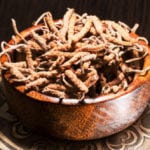 Mysteries
Mysteries  Mysteries
Mysteries  History
History 10 Surprising Stories About the Texas Rangers
 Humans
Humans 10 Philosophers Who Were Driven Mad by Their Own Theories
 Miscellaneous
Miscellaneous 10 Video-Game-Worthy Weapons and Armors from History
 Weird Stuff
Weird Stuff 10 Psychics Who Accurately Predicted Wartime Events
 The Arts
The Arts 10 Pieces of Art Inspired by a Broken Heart
 Health
Health 10 Science Fiction-Sounding New Medical Treatments
 History
History 10 Surprising Facts About the Father of Submarine Warfare
 Space
Space Ten Astonishing New Insights into Alien Worlds
 Weird Stuff
Weird Stuff 10 Bizarre Summer Solstice Rituals Still Practiced Today
 Mysteries
Mysteries Top 10 Haunting Facts About the Ghost Ship MV Alta
 History
History 10 Surprising Stories About the Texas Rangers
 Humans
Humans 10 Philosophers Who Were Driven Mad by Their Own Theories
Who's Behind Listverse?

Jamie Frater
Head Editor
Jamie founded Listverse due to an insatiable desire to share fascinating, obscure, and bizarre facts. He has been a guest speaker on numerous national radio and television stations and is a five time published author.
More About Us Miscellaneous
Miscellaneous 10 Video-Game-Worthy Weapons and Armors from History
 Weird Stuff
Weird Stuff 10 Psychics Who Accurately Predicted Wartime Events
 The Arts
The Arts 10 Pieces of Art Inspired by a Broken Heart
 Health
Health 10 Science Fiction-Sounding New Medical Treatments
 History
History 10 Surprising Facts About the Father of Submarine Warfare
 Space
Space Ten Astonishing New Insights into Alien Worlds
 Weird Stuff
Weird Stuff 10 Bizarre Summer Solstice Rituals Still Practiced Today
10 Horrifying Effects Of Foodborne Illnesses
Swallow. Do you feel a slight tickle at the back of your throat, a barely perceptible ache in your neck? Is your forehead just a little warmer than usual? Sure? Check again. Now take a deep breath, and try not to think about the weird pressure you’ve been feeling around your eyes for the past three hours. You’re probably just tired. Outbreaks caused by foodborne illnesses happen all the time—because only two people need to get sick for the CDC to consider it an official outbreak. That’s hardly cause for alarm.
SEE ALSO: Top 10 Poisonous Foods You Love To Eat
So should you be concerned about parasites and pathogenic bacteria festering in your happy meal? Probably not. But then again . . . maybe you should.
10 Amoebiasis Dissolves Your Organ Tissues
If you’ve ever traveled to a different country and come back with a bad case of diarrhea, you probably picked up what the medical world calls “traveler’s diarrhea,” a relatively minor affliction caused by food that’s carrying bacteria from fecal matter.
Amoebiasis is similar, but much, much worse. Like traveler’s diarrhea, you get it by eating or drinking something with tiny quantities of fecal matter in it. Unlike bacterial traveler’s diarrhea, it’s caused by an amoeba called E. Histolytica. The amoeba enters your body through the digestive tract as a cyst, sort of like an egg. Once inside your warm, incubating stomach, the cyst hatches into a hungry amoeba. At this point, it attacks the layer of mucus lining your intestines.
The mucus lining is intended specifically to block parasites like E. Histolytica from getting through, and it usually works. But sometimes, the amoeba is able to dig all the way through to the soft tissue of your intestinal wall, where it begins secreting enzymes that break down the tissue’s proteins.
Once the intestinal wall is sufficiently dissolved, the amoeba slurps up the resulting goo and begins reproducing. Some newborn cysts are swept away in the bowel stream to continue the cycle elsewhere, while others hatch and grow in the same intestines, spreading, eating, and digging. It’s incredibly painful.
9 Ciguatoxins Reverse How You Feel Hot And Cold

Every time you eat fish, there’s a chance that you’ll die a horrible death. And while there are many ways for that to happen, one of the worst is via ciguatoxin. Ciguatoxins bioaccumulate, which means they build up as they move up the food chain. They’re produced by a type of plankton called a dinoflagellate, and by the time the toxin makes it through the gauntlet of coral, then herbivorous fish, then increasingly larger carnivores, and finally onto your dinner plate, the toxin has accumulated to biblical proportions. And that’s when things get messy.
You start to feel the toxin about two hours after eating a tainted fish—indigestion, nausea, and cramps are usually the first signs. If you’re lucky, it stops there (and it often does). But if you’re particularly susceptible to ciguatoxins, they go to work on your nervous system. You might get lightheaded, tingly, or short of breath. Your heart will be racing a mile a minute and your lips will go numb.
Finally, your neurological processes will start to misfire. One of the strangest examples of this is a reversal of your perception of hot and cold. Ice will feel like it’s burning while a lit stove will feel like, well, ice. It would almost make an interesting superpower if it didn’t signal complete neurological degeneration.
8 Cryptosporidium Corrodes Your Intestines
We’ve talked about cryptosporidium in the past. It’s usually found in contaminated drinking water, though it can also be transmitted through unwashed food. But we haven’t till now covered what happens after the bug gets inside you.
Cryptosporidium is a protozoan parasite that needs a living host to reproduce. It enters your body as microscopic oocysts, which hatch in your belly and travel through the digestive system into your intestines. There, they make a new home among your villi, a forest of tiny, finger-like tentacles that line the inside of your intestines and pull nutrients from the passing food.
But like humans on the world of Pandora, they’re not content to live among the trees. The longer they stay, the more they erode at the life-giving villi. Eventually, the intestinal wall is laid completely bare for long stretches, a condition known as villous atrophy. Give it enough time, and cryptosporidium will corrode the intestines right down to the naked tissue. The most common victims are children.
7 Salmonella Melts Your Bones
Salmonella is one of the most well-known pathogenic bacteria in the world; it’s why you always cook chicken before you eat it. Usually, salmonella stays in the gastrointestinal region, causing a few days of diarrhea and stomach cramps. But sometimes, it goes exploring. And when that happens, you’re in for a rough experience.
For some reason, rogue salmonella bacteria often migrate to the bones, especially leg bones that have a strong blood supply. The bacteria swim through your bloodstream until they reaches the marrow and cause an infection, a condition known as osteomyelitis.
Streams of white blood cells arrive to flush out the threat and begin releasing enzymes that have a very unique effect: They “lyse” the bone, or break down the cells into a fluid. The result is thick pockets of pus where solid bone once stood—prisons for the salmonella, where they’ll eventually undergo necrosis and die.
6 Yersinia Exactly Mimics Appendicitis
 Yersinia bacteria are ingenious little monsters. They’re what’s known as facultative anaerobes—they breathe oxygen if there’s oxygen around; if not, a biological switch flips and lets them “breathe” through fermentation. And it all happens inside your body. You usually end up with yersinia after eating salad—the bacteria can survive at temperatures as low as 4 °C (39.2 °F), which lets it thrive on vegetables in restaurant refrigerators.
Yersinia bacteria are ingenious little monsters. They’re what’s known as facultative anaerobes—they breathe oxygen if there’s oxygen around; if not, a biological switch flips and lets them “breathe” through fermentation. And it all happens inside your body. You usually end up with yersinia after eating salad—the bacteria can survive at temperatures as low as 4 °C (39.2 °F), which lets it thrive on vegetables in restaurant refrigerators.
One of the most dangerous effects of a yersinia infection is pseudoappendicitis, which looks and acts exactly like regular appendicitis. In appendicitis, a major passageway in the appendix gets blocked, and over time the appendix fills with pus and mucus, expanding and putting pressure on the surrounding tissue. Eventually, it bursts, releasing that cesspool of fluids into the body cavities. Yersinia does the same thing, only the bacteria causes the initial blockage that makes the appendix swell.
5 Cryptococcosis Grows Mold On Your Brain

If you’ve ever needed a reason to wash your fruits and vegetables before eating them, here it is.
Cryptococcus neoformans is a fungus that’s found all over the world. Pick up a random handful of dirt and there’s a good chance some of this fungus will be living in it. Now drop that dirt and don’t take any deep breaths, because Cryptococcus is a merciless killer.
The fungus enters your body through your respiratory system, sending a cloud of basidiospores into your lungs and nasal passages. The first thing you’ll feel is a light tickle in your throat that quickly grows into a hacking cough. You’ll get a fever and some of the most intense headaches of your life. The fungus is now spreading across your lungs and releasing toxins into your bloodstream.
After a week or two, the fungus will spread to your central nervous system, sending fingers along your spinal cord that weave their way closer to your brain stem. There, the fungus spreads over your meninges, a thin layer of tissue that blankets the brain. You’ll begin to hallucinate. You may not die, but there’s a good chance of permanent neurological damage.
4 Trichinella Worms Create Colonies Inside Your Tongue

Trichinella is a parasitic nematode that lives in the bodies of omnivores—especially pigs, horses, rats, and humans. Since pigs are the only member of that group we eat regularly, trichinella is usually associated with raw or undercooked pork. And it’s devious.
The worm’s larvae live in cysts in the animal’s muscle tissue. When the animal is killed, packaged, and sent to the grocery store, the cysts hitch a ride down in the meat, waiting for an ideal place to wake up and begin reproducing. More often than not, that ideal place is a person’s stomach. The larvae make their way to the small intestine, latch onto its mucus lining, and begin pumping out babies. In the four weeks they’re alive, adult trichinella can produce more than 1,000 larvae.
These larvae are born diggers—their mouths are equipped with a stylet, a long serrated needle that tears the intestine’s walls so the larvae can swim into the bloodstream. There, they can pick and choose their destination like passengers on a subway. Ideally, they’re looking for thin, active muscle tissue. And nothing fits that description better than a tongue. Sometimes colonies of more than 1,500 worms form gram of tissue. And, sometimes, you never know they’re there.
3 Anisakiasis Forces You To Firebomb Your Own Tissues

In an undersea parallel to pork, squid meat often contains a dangerous parasitic nematode that migrates to humans when it’s not fully cooked. The worm in question is Anisakis simplex, a roundworm that lives in the gastrointestinal tract. Surprisingly, A. simplex by itself isn’t terribly harmful, unless you happen to have an allergic reaction to it. The real danger comes from what it forces your body to do.
Enter eosinophils, our second player in this diminutive drama of death. Eosinophils are a type of white blood cell that are mainly responsible for dealing with parasites. But like a bumbling detective in a David Zucker film, they end up doing more harm than good. Eosinophils mass around the nematodes and launch cytotoxins at them, toxins which do zero damage to the shell of the parasite. Instead, they hit the surrounding tissues and cause more damage than A. simplex could ever dream of doing.
And since the threat is still there, they call in reinforcements, until the entire site is a flashing barrage of crossfire that hits everything but the intended target. And you can die from that.
2 Brucellosis Slowly Rips Your Spinal Cord Apart
There’s a laundry list of alternate names for Brucellosis, including Maltese fever and Bang’s disease. All of them are really the same thing: an infection of brucella bacteria, which is usually found in soft cheese and unsterilized milk. To inject some optimism into this list, Brucellosis is fairly rare, and you’re unlikely to get it if you drink pasteurized milk.
But now for the bad news: It’s a chronic condition that lasts for life, and it can tear your spine in half. See, one of the major complications of Brucellosis is a spinal condition called arachnoiditis, and the combination of those two often leads to syringomyelia, a condition where cavities begin to appear along the spine. The cavities expand over a period of years, forcing apart the spine’s discs and rupturing the whole column along several points. Ouch.
1 The Chicken Superbug Triggers Cellular Suicide
Calling the antibiotic-resistant bacteria that’s being found all over chicken a “superbug” is great for shock value, but it’s really just another version of E. Coli. That being said, it’s still something to watch out for, because it’s causing a surprisingly high rate of hemolytic-uremic syndrome.
Hemolytic-uremic syndrome is the wholesale suicide of red blood cells. Most cells in the body are programmed to be able to self-destruct when needed. It’s called apoptosis, and it usually serves a purpose. For example, when you were still an embryo, your fingers were meshed into a single clump until the cells in between the individual digits underwent apoptosis and allowed your fingers to separate.
But E. Coli contains something called Shiga toxin, which hacks the programming of red blood cells and forces them to commit suicide. The result is near-total kidney failure. Since we’re having trouble stopping this new breed of E. Coli with antibiotics, complications like this are becoming more common. Right now, it’s estimated that about 50 percent of chicken in stores has the superbug.
Who’s hungry?








